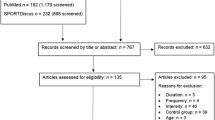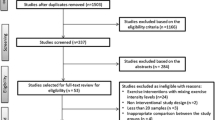Abstract
Eccentric exercise has gained increasing attention as a suitable and promising intervention to delay or mitigate the known physical and physiological declines associated with aging. Determining the relative efficacy of eccentric exercise when compared with the more conventionally prescribed traditional resistance exercise will support evidence-based prescribing for the aging population. Thus, original research studies incorporating chronic eccentric exercise interventions in the older adult population were included in this review. The effects of a range of eccentric exercise modalities on muscular strength, functional capacity, body composition, muscle architecture, markers of muscle damage, the immune system, cardiovascular system, endocrine system, and rating of perceived exertion were all reviewed as outcomes of particular interest in the older adult. Muscular strength was found to increase most consistently compared with results from traditional resistance exercise. Functional capacity and body composition showed significant improvements with eccentric endurance protocols, especially in older, frail or sedentary cohorts. Muscle damage was avoided with the gradual progression of novel eccentric exercise, while muscle damage from intense acute bouts was significantly attenuated with repeated sessions. Eccentric exercise causes little cardiovascular stress; thus, it may not generate the overload required to elicit cardiovascular adaptations. An anabolic state may be achievable following eccentric exercise, while improvements to insulin sensitivity have not been found. Finally, rating of perceived exertion during eccentric exercise was often significantly lower than during traditional resistance exercise. Overall, evidence supports the prescription of eccentric exercise for the majority of outcomes of interest in the diverse cohorts of the older adult population.
Similar content being viewed by others
References
Abbott BC, Bigland B, Ritchie JM. The physiological cost of negative work. J Physiol. 1952;117:380–90.
Katz B. The relation between force and speed in muscular contraction. J Physiol. 1939;96:45–64.
Hortobagyi T, Zheng D, Weidner M, et al. The influence of aging on muscle strength and muscle fiber characteristics with special reference to eccentric strength. J Gerontol A Biol Sci Med Sci. 1995;50A(6):B399–406.
Lindstedt SL, LaStayo PC, Reich TE. When active muscles lengthen: properties and consequences of eccentric contractions. News Physiol Sci. 2001;16:256–61.
Gault ML, Clements RE, Willems MET. Functional mobility of older adults after concentric and eccentric endurance exercise. Eur J Appl Physiol. 2012;112:3699–707.
Theodorou AA, Panayiotou G, Paschalis V, et al. Stair descending exercise increases muscle strength in elderly males with chronic heart failure. BMC Res Notes. 2013;6:87.
Leszczak TJ, Olson JM, Stafford J, et al. Early Adaptations to eccentric and high-velocity training on strength and functional performance in community-swelling older adults. J Strength Cond Res. 2013;27(2):442–8.
Raj IS, Bird SR, Westfold BA, et al. Effects of eccentrically biased versus conventional weight training in older adults. Med Sci Sports Exerc. 2012;44:1167–76.
Reeves ND, Maganaris CN, Longo S, et al. Differential adaptations to eccentric versus conventional resistance training in older humans. Exp Physiol. 2009;94(7):825–33.
Jimenez-Jimenez R, Cuevas MJ, Almar M, et al. Eccentric training impairs NF-kB activation and over-expression of inflammation-related genes induced by acute eccentric exercise in the elderly. Mech Ageing Dev. 2008;129:313–21.
Bellew JW, Yates JW. Concentric versus eccentric strength of the quadriceps femoris in elderly and young women. J Strength Cond Res. 2000;14(4):419–25.
Buford TW, MacNeil RG, Clough LG, et al. Active muscle regeneration following eccentric contraction-induced injury is similar between healthy young and older adults. J Appl Physiol. 2014;116:1481–90.
Chapman DW, Newton M, McGuigan MR, et al. Comparison between old and young men for responses to fast velocity maximal lengthening contractions of the elbow flexors. Eur J Appl Physiol. 2008;104:531–9.
Chen TC, Tseng WC, Huang GL, et al. Low-intensity eccentric contractions attenuate muscle damage induced by subsequent maximal eccentric exercise of the knee extensors in the elderly. Eur J Appl Physiol. 2013;113:1005–15.
Hortobagyi T, Dempsey L, Fraser D, et al. Changes in muscle strength, muscle fibre size and myofibrillar gene expression after immobilization and retraining in humans. J Physiol. 2000;524(1):293–304.
Klass M, Baudry S, Duchateau J. Aging does not affect voluntary activation of the ankle dorsiflexors during isometric, concentric, and eccentric contractions. J Appl Physiol. 2005;99:31–8.
Lavender AP, Nosaka K. Responses of old men to repeated bouts of eccentric exercise of the elbow flexors in comparison with young men. Eur J Appl Physiol. 2006;97:619–26.
Nogueira FRD, Libardi CA, Nosaka K, et al. Comparison in response to maximal eccentric exercise between elbow flexors and knee extensors of older adults. J Sci Med Sport. 2014;17:91–5.
Jacobs JL, Marcus RL, Morrell G, et al. Resistance exercise with older fallers: its impact on intermuscular adipose tissue. Biomed Res Int. 2014. doi:10.1155/2014/398960.
Fielding RA, Meredith CN, O’Reilly KP, et al. Enhanced protein breakdown after eccentric exercise in young and older men. J Appl Physiol. 1991;71(2):674–9.
Sacheck JM, Milbury PE, Cannon JG, et al. Effect of Vitamin E and eccentric exercise on selected biomarkers of oxidative stress in young and elderly men. Free Radic Biol Med. 2003;34(12):1575–88.
LaStayo P, McDonagh P, Lipovic D, et al. Elderly patients and high force resistance exercise—a descriptive report: can an anabolic, muscle growth response occur without muscle damage or inflammation? J Geriatr Phys Ther. 2007;30:128–34.
LaStayo PC, Ewy GA, Pierotti DD, et al. The positive effects of negative work: increased muscle strength and decreased fall risk in a frail elderly population. J Gerontol A Biol Sci Med Sci. 2003;58A(5):419–24.
Mueller M, Breil FA, Lurman G, et al. Different molecular and structural adaptations with eccentric and conventional strength training in elderly men and women. Gerontology. 2011;57:528–38.
Mueller M, Breil FA, Vogt M, et al. Different response to eccentric and concentric training in older men and women. Eur J Appl Physiol. 2009;107:145–53.
Takahashi ACM, Melo RC, Quiterio RJ, et al. The effect of eccentric strength training on heart rate and on its variability during isometric exercise in healthy older men. Eur J Appl Physiol. 2009;105:315–23.
Melo RC, Quiterio RJ, Takahashi ACM. High eccentric strength training reduces heart rate variability in older men. Br J Sports Med. 2008;42:59–63.
Masud T, Morris RO. Epidemiology of falls. Age Ageing. 2001;30(4):3–7.
Adams GM, Beam WC. Exercise physiology: laboratory manual (5th edition). New York: McGraw-Hill; 2008.
Valour D, Rouji M, Pousson M. Effects of eccentric training on torque-angular velocity-power characteristics of elbow flexor muscles in older women. Exp Gerontol. 2004;39:359–68.
Pereira A, Izquierdo M, Silva AJ, et al. Effects of high-speed power training on functional capacity and muscle performance in older women. Exp Geront. 2012;47(3):250–5.
LaStayo PC, Meier W, Marcus RL, et al. Reversing muscle and mobility deficits 1 to 4 years after TKA. Clin Orthop Relat Res. 2009;467:1493–500.
Porter MM, Vandervoort AA. Standing strength training of the ankle plantar and dorsiflexors in older women, using concentric and eccentric contractions. Eur J Appl Physiol. 1997;76:62–8.
Symons TB, Vandervoort AA, Rice CL, et al. Effects of maximal isometric and isokinetic resistance training on strength and functional mobility in older adults. J Gerontol Med Sci. 2005;60A:777–81.
Singh MAF, Ding W, Manfredi TJ, et al. Insulin-like growth factor I in skeletal muscle after weight-lifting exercise in frail elders. Am J Physiol. 1999;277:135–43.
Borg G. Perceived exertion as an indicator of somatic stress. Scand J Rehab Med. 1970;2:92–8.
Tiedemann AC, Sherrington C, Lord SR. Physical and psychological factors associated with stair negotiation performance in older people. J Gerontol Med Sci. 2007;62A(11):1259–65.
Purtsi J, Vihko V, Kankaanpaa A, et al. The motor-learning process of older adults in eccentric bicycle ergometer training. J Aging Phys Act. 2012;20:345–62.
Buchner DM, Larson EB, Wagner EH, et al. Evidence for a non-linear relationship between leg strength and gait speed. Age Ageing. 1996;25:386–91.
Berg K, Dauphinee-Wood S, Williams JI, et al. Measuring balance in the elderly: preliminary development of an instrument. Physiother Can. 1989;41(6):304–11.
Addison O, Drummond MJ, LaStayo PC, et al. Intramuscular fat and inflammation differ in older adults: the impact of frailty and inactivity. J Nutr Health Aging. 2014;18(5):532–8.
Nilwik R, Snijders T, Leenders M, et al. The decline in skeletal muscle mass with aging is mainly attributed to a reduction in type II muscle fiber size. Exp Gerontol. 2013;48:492–8.
Visser M, Kritchevsky SB, Goodpaster BH, et al. Leg muscle mass and composition in relation to lower extremity performance in men and women aged 70 to 79: the health, aging and body composition study. J Am Geriatr Soc. 2002;50:897–904.
Marcus RL, LaStayo PC, Dibble LE, et al. Increased strength and physical performance with eccentric training in women with impaired glucose tolerance: a pilot study. J Womens Health. 2009;18:253–60.
Scrivo R, Vasile M, Bartosiewicz I, et al. Inflammation as a “common soil” of the multifactorial diseases. Autoimmun Rev. 2011;10(7):369–74.
Chahal HS, Drake WM. The endocrine system and ageing. J Pathol. 2007;211:173–80.
Nikolaidis MG, Kyparos A, Spanou C, et al. Aging is not a barrier to muscle and redox adaptations: applying the repeated eccentric exercise model. Exp Gerontol. 2013;48:734–43.
Drexel H, Saely CH, Langer P, et al. Metabolic and anti-inflammatory benefits of eccentric endurance exercise—a pilot study. Eur J Clin Invest. 2008;38(4):218–26.
Author information
Authors and Affiliations
Corresponding author
Ethics declarations
Funding
No sources of funding were used to assist in the preparation of this review.
Conflict of interest
Ashley Gluchowski, Nigel Harris, Deborah Dulson and John Cronin have no conflicts of interest relevant to the content of this review.
Rights and permissions
About this article
Cite this article
Gluchowski, A., Harris, N., Dulson, D. et al. Chronic Eccentric Exercise and the Older Adult. Sports Med 45, 1413–1430 (2015). https://doi.org/10.1007/s40279-015-0373-0
Published:
Issue Date:
DOI: https://doi.org/10.1007/s40279-015-0373-0




